Variety of varieties FROM hybrids of lilies
To date, a huge number of different varieties of OT hybrids of lilies have been bred, the catalog of which has more than a dozen unique varieties. All of them have different features of appearance, stem height and color of inflorescences. Consider the characteristics of the most popular varieties of this category of lilies.
- Lilium Anastasia cultivar. It is a tall plant whose stem can reach 2 meters. At the same time, it is distinguished by great elegance. The flowers are large, pinkish with a white center. There are greenish veins in the central part of the petals. The petals of the flowers are bent back. Anthers are brownish.
- Lilium Donato variety. Another very beautiful and bright variety of OT lily hybrids. It can grow in height up to 1.5-2 meters. It differs in rather large flowers, which can reach about 25 cm in diameter. The inflorescences have a purple-red hue with purple blotches. The throat of the inflorescence is wavy, yellowish-white.
- Lilium Honeymoon cultivar. It is a medium-sized plant that can reach a maximum height of 1 meter. The variety is distinguished by its late flowering. Large, up to 30 cm in diameter, pale yellow flowers bloom on the stems. On average, one plant can contain from 2 to 12 flowers.
- Altari variety. The plant is 110-120 cm tall and has a late flowering that begins in August. Funnel-shaped inflorescences are directed to the sides, have a two-color color - cream petals with a crimson core. The diameter of one flower can be 15-20 cm. One inflorescence can consist of 5-8 flowers, which exude a pleasant and delicate aroma.
- Double Yellow variety. A very beautiful and spectacular variety of OT hybrids, which is distinguished by inflorescences of a yellow shade, which is similar to the color of lime. Terry flowers, exude a lemon scent.
- Boogie Woogie variety. It is a plant that can reach a height of about 100-110 cm. Beautiful white-pink flowers bloom on the top of the stems, which are directed to the sides. The inflorescences exude a pleasant aroma, similar to the smell of lilies of the valley.
- Purple Prince cultivar. This is one of the most popular varieties of OT hybrids. Differs in rather large flowers with satin petals. When the flower blooms, it takes on a burgundy purple hue. When closed, the bud of this lily is almost black in color.
- Lilium Conca d Or. It is a plant that can reach a height of just over 1 meter. This variety can please with a long flowering period that lasts up to 100 days. Flowers are large up to 28 cm in diameter and have a pleasant aroma.
- Red Dutch variety. It is a plant up to 120 cm high. The flowering of the plant begins around mid-summer. The lily of this variety blooms with wine-red inflorescences with yellow tips.
- Lilium Robina cultivar. This variety is distinguished by rather tall stems, which can reach a height of 1.5 m. Dark markings are present on the green stems. The flowers are large, purple-red with a whitish throat.
- Lilium Miss Feya. It is a short plant that can grow as little as 1 meter. The stems are strong and very strong, covered with dark green foliage. The flowers are large, can reach about 25 cm in diameter. The petals of flowers are purple-red with a white edging around the edge.
- Lilium Ovatie cultivar. This variety boasts tall and sturdy stems that grow up to 1.5 meters. Large cupped flowers of a white shade with a greenish neck bloom on the branches.
- OT variety of Lilium Sheherazade hybrids.A very effective variety of lilies, which is distinguished by high stems up to 2.5 m, on which an average of 30 wilted flowers can form. The inflorescences can reach about 25 cm in diameter and are dark red in color. Flowering begins around the end of summer.
- Variety Nazeri Karillon. It is also a tall variety, which is distinguished by very large inflorescences, reaching a diameter of 30 cm. Flowers are of a whitish-crimson hue with a pleasant aroma.
- Touching variety. It is a tall plant, the stems of which can reach 120-130 cm. The flowering of the variety falls at the end of July or the beginning of August. Flowers are dark yellow with a reddish star in the center.
Beautiful flower beds with lilies: 7 schemes
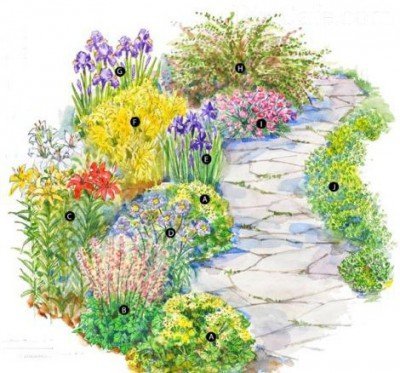
A. Soft cuff (Alchemilla mollis) 2 pcs. B. Heuchera (Heuchera "Champagne Bubbles") 1 pc. C. Lily (Lilium) 3 pcs. D. Scabiosa (Scabiosa "Butterfly Blue") 1 pc. E. Siberian Iris (Iris sibirica) 3 pcs. F. Japanese Spirea (Spiraea japonica "Goldmound") 1 pc. G. Iris (Iris) 3 pcs. H. Barberry Thunberg (Berberis thunbergii) 1 pc. I. Armeria maritima 3 pcs. J. Sedum Kamchatka (Sedum kamtschaticum) 9 pcs.
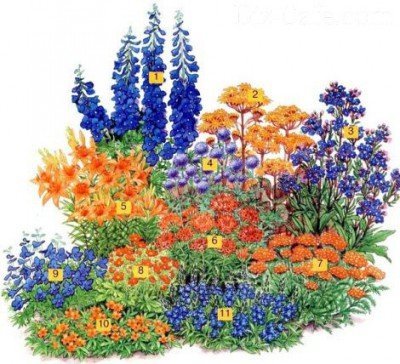
1. Delphinium tall dark blue (Delphinium). 2. Buzulnik toothed (Ligularia dentata). 3. Anchusa azurea (Anchusa azurea) "Loddon Royalist". 4. Common mordovan (Echinops ritro). 5. Lily "Enchantment". 6. Phlox "Citrus" 7. Yarrow (Achillea) "Terracotta". 8. Crimson gravilate (Ceum coccineum) "Werner Arends". 9. Low-growing large-flowered burgundy (Delphinium grandiflorum) "Blauer Zwerg". 10. Cinquefoil Tonga (Potentilla tonguei). 11. Veronica broadleaf (Veronica teucrium) "Kapitaen".

1. Chubushnik (Philadelphus). 2 Phlox paniculata (Phlox paniculata). 3. Hybrid peony (Paeonia x hybr.). 4. Tiger lily (Lilium tigrinum). 5. Ageratum Mexican (Ageratum houstonianum). 6. Lobularia maritima. 7. Turkish carnation (Dianthus barbatus).

Tall lilies of three shades of one type will successfully complement the design of the fence of the garden plot
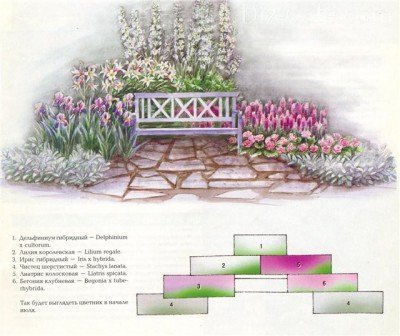
Delicate pink lilies in combination with delphinium and irises will subtly complement the design of the garden seating area

Bright orange lilies will become an expressive accent on a flower bed with conifers and stunted perennials
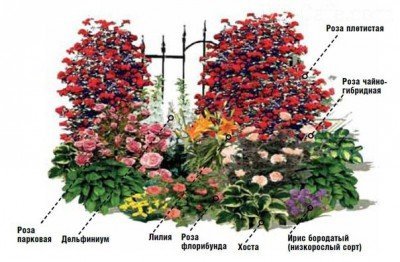
Orange lilies will become an exotic focal point of a flower garden formed from different varieties of roses.
Outdoor cultivation and care
Taking care of tigridia is not particularly difficult, but it is important to follow a number of procedures and rules, especially with regard to the regularity of watering. Weeding the soil and soft loosening are also important
Watering and feeding
This plant requires regular watering. Water should be applied directly to the ground to prevent leaves and petals from getting wet.
In summer, tigridia can be fed with a small amount of mineral fertilizer for flowering plants. It is recommended to add compounds with a high content of potassium and phosphorus several times, if earlier (in the fall, before planting) manure was not applied.
Reproduction
These beautiful plants with exotic flowers can be grown in 2 ways:
- from seeds,
- by dividing the bulbs.
Sowing seeds of tigridia begins in the spring (at a temperature of 13-16 ° C).
The division of the bulbs is carried out in the fall, after digging up. After digging up the kids separated from the mother bulbs. New plants obtained in this way, however, will not bloom until after 2-3 years. From plants propagated by sowing seeds, flowers can be obtained after 2 years.
Diseases and pests
It is worth carrying out prevention against diseases and pests (characteristic of iris plants), including using organic infusions from nettle, horsetail, tansy or onion.
Fortunately, tigridia hardly get sick and are not attacked by pests, which is their undoubted advantage.
To do this, it is important not to plant bulbs in an area where plants from the iris family previously grew, as this contributes to the transmission of diseases.
Wintering when to dig up the bulbs
Since tigridia are not resistant to cold, the bulbs are dug up for the winter, otherwise they will not survive the frost. Some gardeners believe that in regions with mild winters, when the frosts are not severe, they can be left in the ground. Tigridia bulbs are dug up in October, when the leaves begin to turn yellow. Digging is carried out approximately 14 days after flowering.
Work progress:
- First, the aerial part of the bush is cut a few centimeters above the bulb.
- The bulbs are dug out and dried without cleaning the soil for a month at a temperature of 17-20 ° C.
- Then place the bulbs in dry sand or peat and move the boxes to a place with a minimum temperature of 5 ° C. The room for storing planting material must be ventilated.
You can store tigridia bulbs at home, in an apartment - in a dry, ventilated place where the temperature does not drop below 5 degrees Celsius. The temperature should not be too high - the bulbs need a cooling period for flowering. At temperatures above 10 degrees, shoot growth begins. If stored without a cooling period, the bulbs will grow leaves after planting but will not flower.
Tigridia bulbs grown in pots do not need to be dug up for the winter; together with the pot, they are moved from the balcony to the room.
How to plant?
Tiger lily is an unpretentious type of garden plant. However, only if all agrotechnical conditions are observed, you can observe the beautiful flowering of this culture. First of all, you need to choose a favorable place for planting the bulbs. The plant loves the sun, although partial shade is also suitable, near trees. For full development and further flowering, a sufficient amount of light is needed.
There are no specific guidelines for soil type. The only thing is that the earth must be moisture-permeable, since lilies do not tolerate stagnant water. High humidity has a detrimental effect on the root system. Light fertile soil can extend the flowering period, as well as make the flowers brighter.
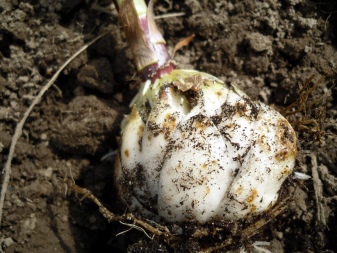

In the northern regions, they begin to plant tiger lilies in the spring, in the southern ones - closer to September, but they have been preparing the soil since the previous fall. For successful rooting, you should choose a soil with low or neutral acidity. If the soil is acidic, ash is added before planting. If the ground is heavy, digging will be required with the addition of sand. Light soil only needs deep loosening (up to about 30 cm).
It is recommended to thoroughly fertilize the earthen hole before planting. For these purposes, humus (a bucket per 1 sq. M), potassium salt (50 g), superphosphates (100 g per 1 sq. M) are perfect. Instead of the above substances, gardeners are advised to use mineral complexes - potassium-phosphorus. You will also need drainage - for example, from sand.


So, first, holes are dug with a depth of 20 cm
In addition, it is important to observe the interval between them - at least 15-20 cm.A drainage layer is laid at the bottom - preferably from river sand
Further, one onion is placed in each hole, lightly covered with soil, and at the end it is watered abundantly.

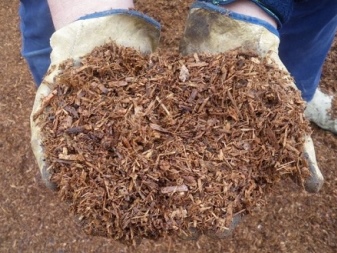
Ontogenesis
The type of seed dormancy is morphophysiological. The seeds ripen in August-September and germinate next spring. Seeds begin to germinate only after the embryo has ripened. Good germination is maintained for 1-2 years with proper storage.
The seedling consists of a primary root, densely covered with root hairs, a short hypocotyl, and a cotyledon, at the base of which an embryonic bud is located. In the state of a seedling, a curly lily forms a bulb, which contributes to the survival of the seedling in the winter period. The cotyledon is formed by the haustorium, the sheath, and the petiole that connects the haustorium to the vagina. The cotyledon grows poorly and is not carried to the soil surface. The length of the petiole is 5-7 mm. The type of seed germination is hypogeal and characterized by a long germination period. The duration of the state of the seedling in vivo is from several weeks to 1 year.
Under in vitro conditions, germination of seeds that have undergone a 4–5 month period of cold stratification is observed on days 35–38 of cultivation. The formation of the hypocotileal zone is observed 10 days after germination.
The appearance of the first leaf signals the transition of the seedling to the juvenile state and the autonomous nutrition of the plant. The leaf in natural conditions is small (0.8-2 cm), ovate, with a pointed tip and a long petiole.The cotyledons and the embryonic root die off, the bulb increases in size due to the proliferation of the vagina, adventitious roots with a pronounced contractile zone appear, due to which the plant is drawn into the soil. The first leaf in natural habitat is formed only in the second year of life, after exposure to low temperatures.
In natural habitat in a juvenile state for curly lily, multivariate development is described, associated with the need for exposure to low temperatures for the first leaf to emerge. For some seedlings, the action of low temperatures is necessary for their transition to the juvenile state, but for a certain proportion of seedlings this is not necessary. The duration of the juvenile state in natural habitat is 1-2 years, in vitro culture - 2-3 months.
Plants in the imature state are characterized by the presence of a rosette shoot with one oval-pointed leaf with a pointed tip, 5-8 cm in size, including the petiole. The number of scales in the bulb is 5-7 pieces. Plants enter this ontogenetic state by the end of the third year of life, and under in vitro culture conditions - after 8 months. In this case, a rosette shoot is formed, bearing from 1 to 3 leaves of an oval, lanceolate or linear shape, 3.5-4 cm long. The diameter of the bulb is from 1 to 1.2 cm.
In virginal plants, the first elongated aerial shoot appears. Green leaves are formed on the bulb in the amount of 1-3. This period lasts 3-4 years, during which the number of scales in the bulb increases. Buds can be laid on the shortened part of the shoot in the bulb. Under in vitro culture conditions, up to 3 buds are laid on a shortened shoot, from which daughter bulbs are formed. In this case, the branching of the shortened shoot is observed, and the elongated aerial shoot is not formed.
Landing in rabatkas and on curbs
For planting along the paths and the formation of low borders, the tubular lily and its variety Garrisi lily 70-80 cm high, blooming in July with pure white inflorescences, are perfect.
The white Formosan lily 60-90 cm high with narrow tubular buds is good for the same purposes. But the most effective way will outline the paths, and will also complement the ridges and borders with the low-growing Thunberg lily up to 50 cm high, blooming in May-June with speckled orange flowers.
Another species that can successfully decorate the lower tier of flower beds and decorate alpine hills is a drooping lily 40-60 cm high with pink-lilac turban-shaped flowers.


